According to a McKinsey survey, the proliferation of disruptive technologies emerging as a response to the pandemic “speeded the adoption of digital technologies by several years—and many of these changes could be here for the long haul.”
From shifting to remote work to implementing safety protocols, the pandemic has disrupted how businesses operate and interact with their customers at every level. The rise of virtual events, contactless payments, and online shopping has challenged traditional business models and forced companies to innovate.
Despite being a few years removed from the unprecedented events of COVID-19, major industries worldwide are still figuring out how to adapt and transform to the new normal.
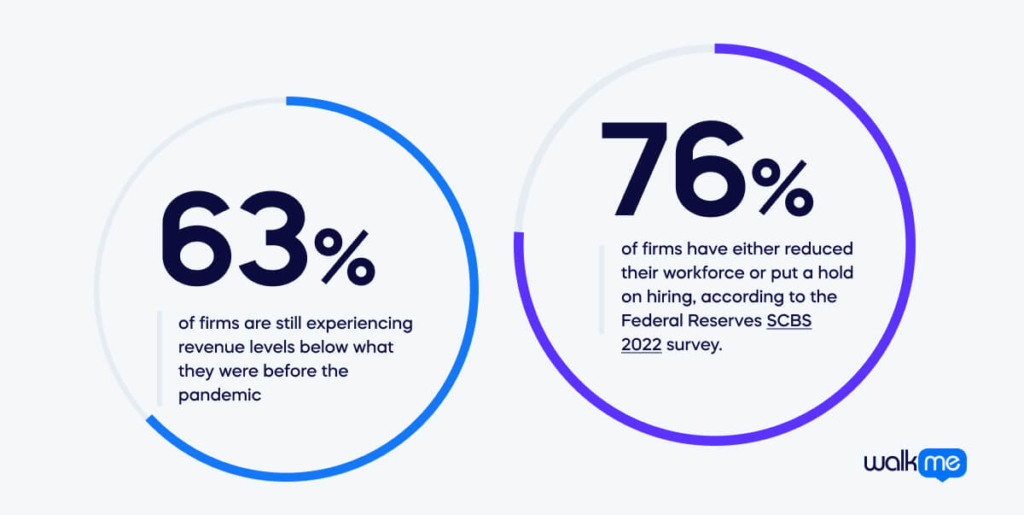
63% of firms are still experiencing revenue levels below what they were before the pandemic, while 76% of firms have either reduced their workforce or put a hold on hiring, according to the Federal Reserves SCBS 2022 survey.
As such, enterprises must rapidly accelerate digital transformation efforts to become future-ready and remain viable in their respective markets. CIOs must avoid deploying short-sighted IT strategies and solutions that only remedy immediate needs and instead align with those that facilitate overall organizational development.
Siloed tech investments that barely scratch the surface of true transformation are no longer enough.
CIOs and IT leaders need to deploy an IT strategic plan that provides a holistic view of the entire IT ecosystem, and that aligns with the ITIL framework – along with the provision of change management efforts that expedite this process.
This article discusses creating an IT strategic plan and provides a step-by-step guide for CIOs and IT leaders. We define an IT strategic plan, who’s responsible for developing it, and the benefits of having one. We cover the essential pillars of a successful IT strategic plan and provide practical examples from various industries. By the end of this guide, we’ll have equipped readers with the tools and knowledge necessary to help create a comprehensive IT strategic plan.
What is an IT Strategic Plan?
An IT strategic plan (Information Technology strategic plan) is a comprehensive roadmap that outlines an organization’s approach to using technology to achieve long-term goals and objectives. It provides a framework for aligning technology investments with business goals and helps guide decision-making around IT initiatives and projects.
SWZD states that “adoption plans have grown significantly YoY for newer technologies such as 5G, edge computing, serverless computing, 3D printing, VR, and blockchain.”
A well-crafted plan considers an organization’s current and future technology needs, as well as its budget, resources, and constraints. It identifies critical systems and applications that support business operations and outlines strategies for managing those systems over time, including upgrades, maintenance, and security measures.
An effective IT strategic plan also includes a clear vision for how technology can drive innovation and growth for the organization.
It explores emerging technologies and trends and assesses their potential impact on the business. It also includes a plan for training and developing IT staff and ensuring they have the skills and knowledge to effectively manage and support technology systems.
Companies that invest in Information Technology (IT) tend to experience higher productivity levels than those that don’t.
Overall, an IT Strategic Plan is a crucial tool for organizations that wish to leverage technology to stay competitive and achieve their goals. It provides a roadmap for aligning technology investments with business objectives and helps ensure that technology initiatives are properly managed and executed to achieve optimal results.
Who’s Responsible for Developing an IT Strategic Plan?
Developing an IT strategic plan is a complex process that requires careful planning and execution.
As such, organizations must assign responsibility to a capable team or individual who can deliver a comprehensive plan that aligns with the company’s goals.
Generally speaking, the responsibility of developing an IT strategic plan falls on senior management or IT leaders, such as a Chief Information Officer (CIO) or Chief Technology Officer (CTO). This is because creating an IT strategic plan involves technical expertise and a keen understanding of business objectives and budget constraints.
A new study from CIO found that IT leaders spent most of their time on practical and transformational work this year, similar to the previous year of 2022.
The IT strategic planning process also requires input from different departments of an organization, including finance, marketing, and operations. IT leaders can collaborate with these teams to gather relevant information, identify gaps and opportunities, and create a prioritized roadmap.
It’s also important for IT leaders to engage with the broader organization and stakeholders to ensure that the strategic plan aligns with the company’s overall mission and vision. This helps to ensure that the IT strategic plan is not isolated and contributes to the organization’s success.
The Benefits of an IT Strategic Plan
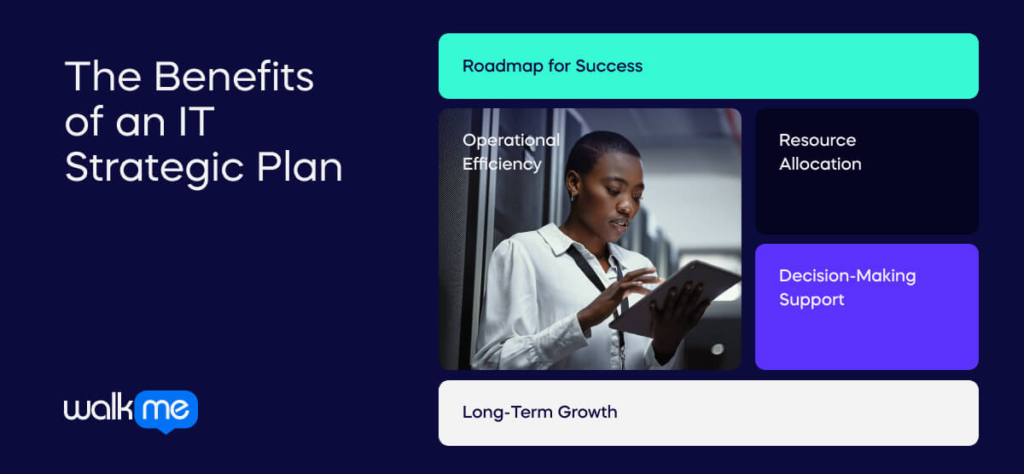
An IT strategic plan offers a multitude of benefits to an organization. At its core, such a plan provides a roadmap for successful and sustainable IT operations; it aligns IT initiatives and resources with business strategy, identifying opportunities for innovation, growth, and improvement across the enterprise.
Consequently, a sound strategic plan can enhance operational efficiency, reduce costs, and improve IT performance, thereby improving overall business performance.
By laying out clear goals, timelines, budgets, and performance metrics, an IT strategic plan can help a company prioritize and allocate resources more effectively; this leads to greater operational agility and responsiveness, increased innovation, and a more competitive market position in the long run.
Moreover, an IT strategic plan supports organizational decision-making and governance while enhancing risk management and security practices. By identifying potential risks and establishing mitigation strategies, a strategic plan anticipates and addresses potential cybersecurity threats, disaster recovery, competitive pressures, and changing market conditions.
Ultimately, implementing and executing a well-designed IT strategic plan can lead to long-term benefits such as increased growth, profitability, and customer satisfaction, while also enhancing organizational agility and competitiveness.
According to Gartner’s forecast, IT spending is expected to increase in all regions worldwide despite global economic turbulence. The report estimates that by 2023, worldwide IT spending will reach $4.6 trillion in total value, representing a 5.5% increase from the previous year.
5 Vital Steps of the IT Strategic Planning Process
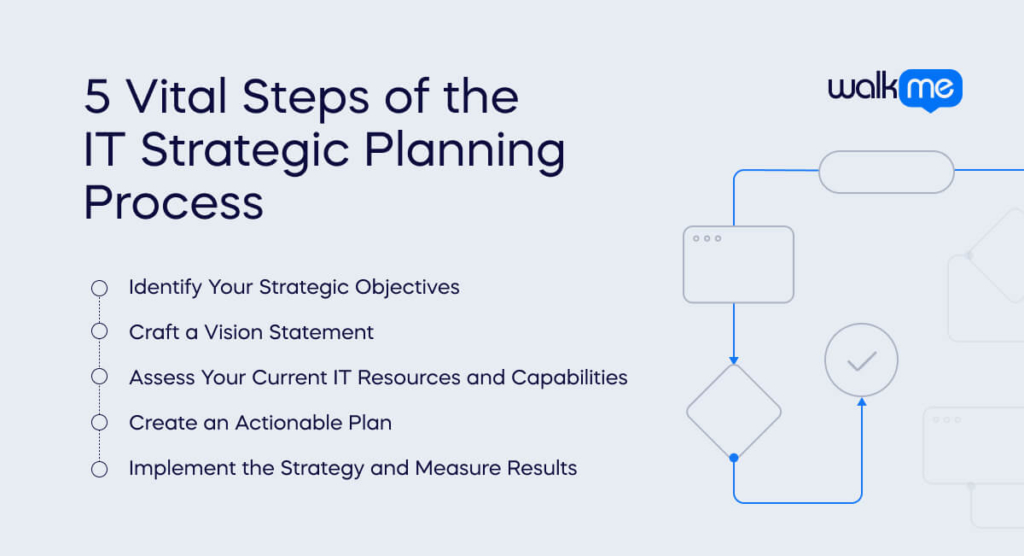
Developing a strategic IT plan is fundamental to the success of any modern business. Effective planning and execution require a methodical, well-structured approach.
By following these five key steps, CIOs and IT leaders can develop a comprehensive strategy designed to meet your organization’s current and future needs and help achieve your business objectives.
Step 1: Identify Your Strategic Objectives
The first step in developing your IT strategy involves identifying your goals and desired outcomes.
To accomplish this, you must understand your organization’s current state and what you hope to achieve through your IT strategy. This clarity will help you determine what success looks like, allowing you to measure your progress over time.
Step 2: Craft a Vision Statement
Once you have identified your strategic objectives, the next step is to create a vision statement that reflects your IT strategy’s aspirations.
This statement should outline the purpose of your IT plan and explain how it will achieve your organization’s goals. By aligning your IT leaders and team members to your cause, your vision statement will inspire them to work towards a common set of objectives.
Step 3: Assess Your Current IT Resources and Capabilities
In order to create an effective IT strategy, you must assess your current IT resources and capabilities. This includes evaluating your existing technology to identify any gaps or opportunities for improvement.
By understanding your IT department’s strengths and weaknesses, you can identify specific areas for improvement and ensure that your IT strategy is designed to address your organization’s unique needs.
Step 4: Create an Actionable Plan
In this penultimate step, you must create an actionable plan to achieve your IT strategy’s goals. This involves creating an IT roadmap that outlines the tasks, resources, and timelines required to achieve your desired outcomes.
By focusing on specific initiatives and tracking progress over time, you can adjust your IT strategy as necessary to ensure it remains aligned with your organization’s evolving needs.
Step 5: Implement the Strategy and Measure Results
Implementing your IT strategy involves setting up the necessary systems and processes to execute your plan effectively.
You’ll need to allocate resources, manage projects, and maintain governance. After implementation, regularly monitor progress, measure results against KPIs, and adjust your approach accordingly. Change management tools can help you gain insights into the effectiveness of your IT strategy and identify opportunities for further technology investment.
IT Strategic Plan Examples
Strategic IT planning is a critical activity that ensures the effective use of technology to achieve a company’s goals and objectives. However, given that companies have varying objectives, strategic IT plans can take on many forms.
Depending on an organization’s nature, scope, and size, the format of strategic IT plans can differ significantly. For instance, a small business might have a basic plan that outlines its technology requirements. At the same time, a larger conglomerate may require a more comprehensive plan that covers various departments and business units.
To provide a clearer picture of the variations that exist among strategic IT plans, here are four examples for your consideration:
Harvard University IT Strategic Plan Template:
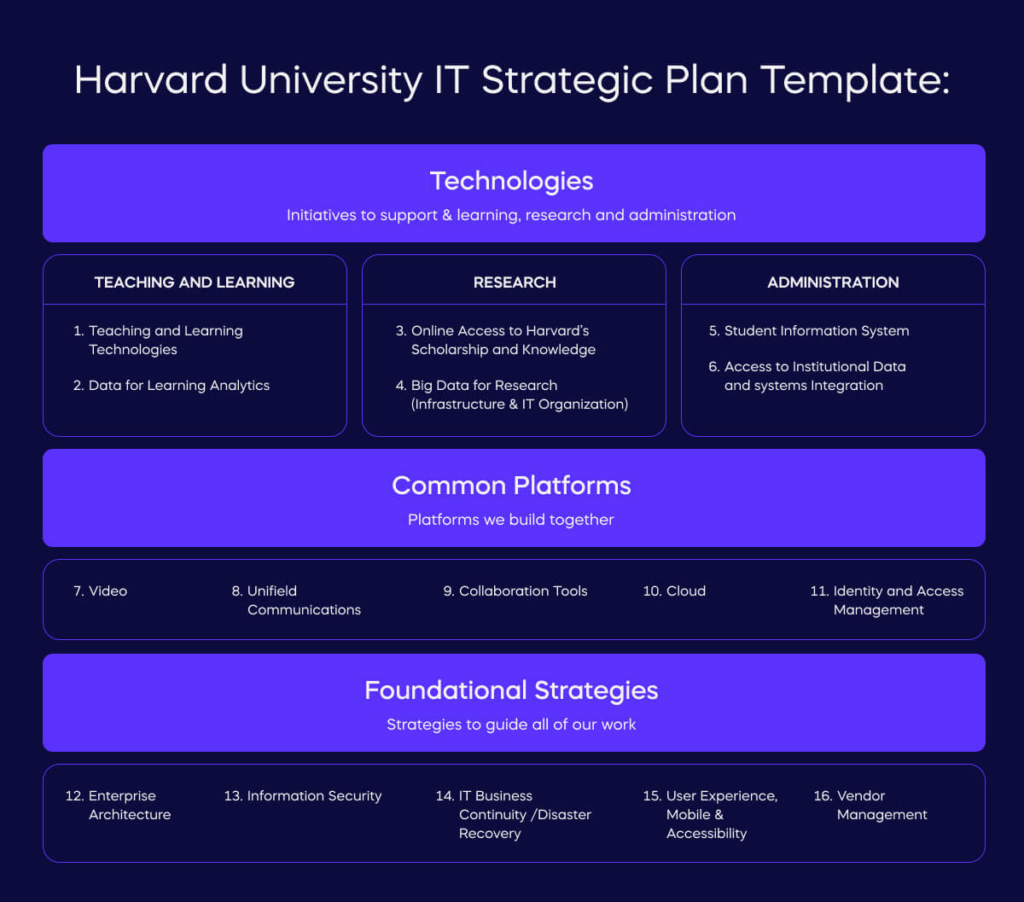
Resolute Technology Solutions IT Strategic Plan Template:
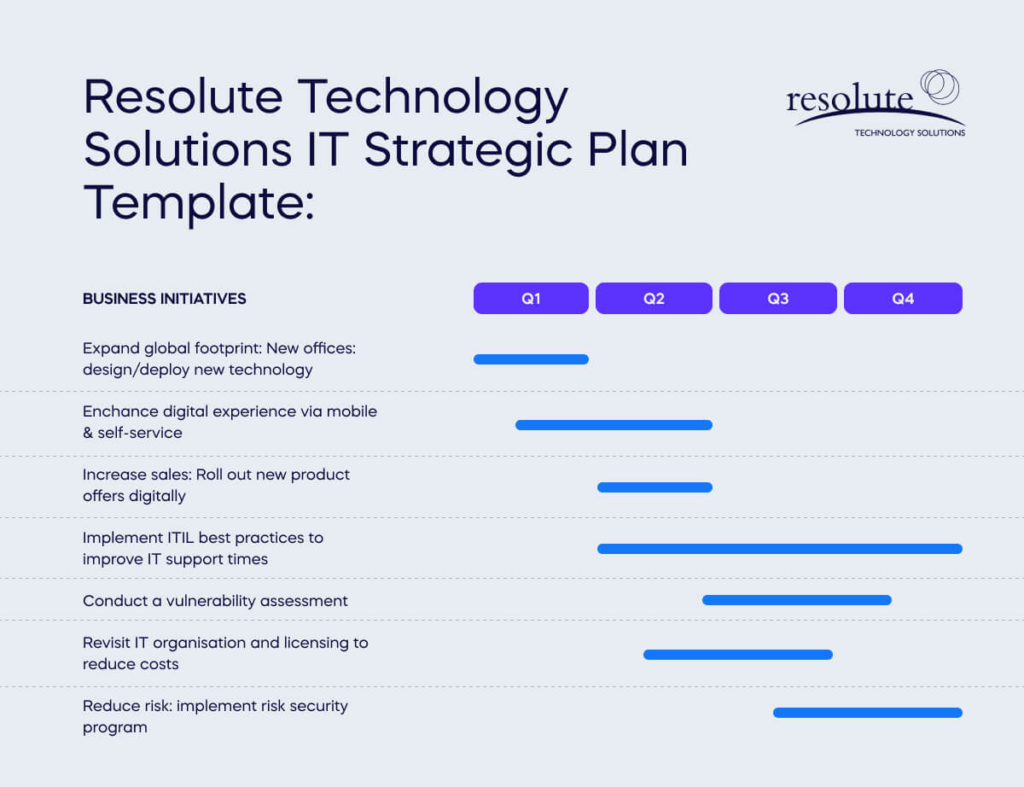
Gartner’s IT Strategic Plan Example Template:
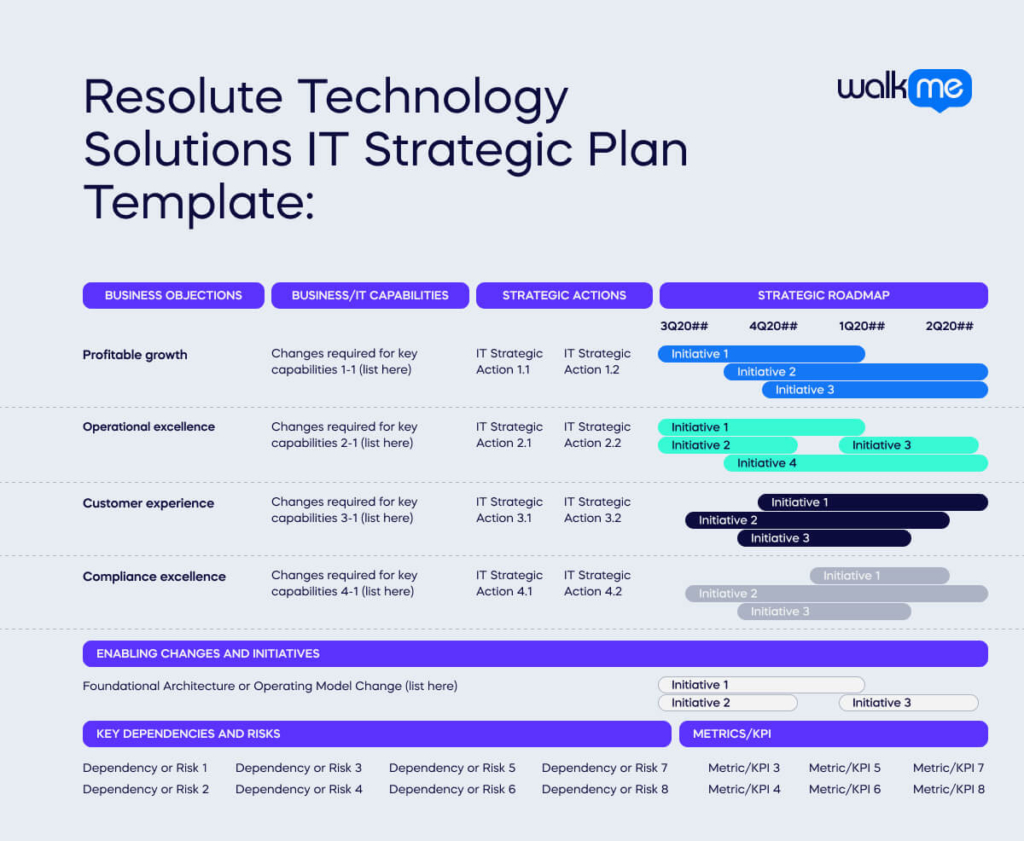
City of Cambridge’s 180-day IT Strategic Plan:
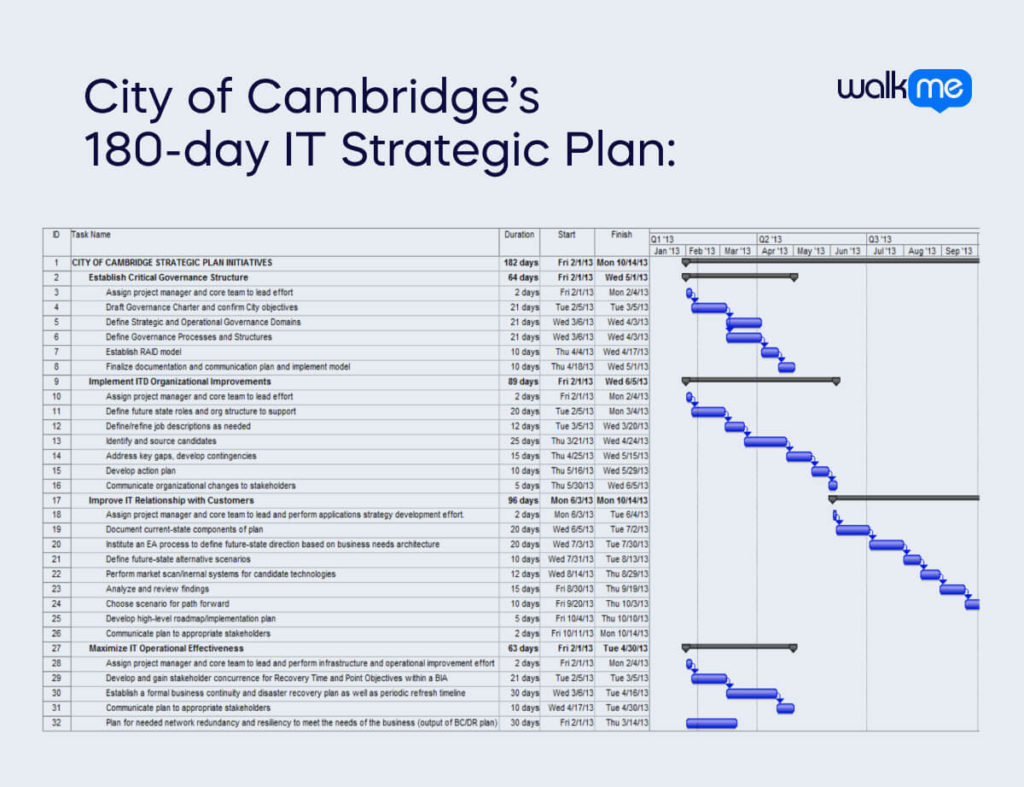
The Best Piece of Strategic Planning Advice We Can Offer
Kirk Reickhoff, Senior Partner at McKinsey, states that a great leader provides a rough outline for the team to figure out the rest. An IT strategic plan is the foundation of your IT transformation journey, guiding your progress and ensuring continuity. It is an iterative process that requires regular updates to stay up-to-date.
However, your employees are the driving force behind your success. They are the meat and muscle of your IT organization, pushing you forward and keeping you going. An IT strategic plan can guide you, but it’s ultimately up to your team to execute it successfully.
For an IT strategic plan to be effective, it must align with and reinforce the overall business vision. It is critical to avoid siloed thinking and ensure that all technology-related investments and initiatives are fully integrated and help advance the organization’s broader mission and objectives.
Every dollar spent on IT must be fully accounted for and justified based on its contribution to achieving the company’s overall goals.
McKinsey reports that as CIOs face budgets of $500 million or more, they’re increasingly seeking IT providers to help support and strengthen their internal talent’s ability to innovate and drive the company’s digital strategy. This is partly due to a desire to sustain innovation in critical business areas and those that interact directly with customers.
As a CIO or IT leader, it is imperative to clearly understand the business goals and how IT can aid in achieving them. By following the steps in this article, CIOs and IT leaders can begin to create a strategic plan that cultivates a collaborative process between IT and business leaders, focusing on aligning IT initiatives with the company’s overall objectives.

